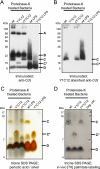Resistance of Capnocytophaga canimorsus to killing by human complement and polymorphonuclear leukocytes
- PMID: 19307219
- PMCID: PMC2687352
- DOI: 10.1128/IAI.01324-08
Resistance of Capnocytophaga canimorsus to killing by human complement and polymorphonuclear leukocytes
Abstract
Capnocytophaga canimorsus is a bacterium of the canine oral flora known since 1976 to cause rare but severe septicemia and peripheral gangrene in patients that have been in contact with a dog. It was recently shown that these bacteria do not elicit an inflammatory response (H. Shin, M. Mally, M. Kuhn, C. Paroz, and G. R. Cornelis, J. Infect. Dis. 195:375-386, 2007). Here, we analyze their sensitivity to the innate immune system. Bacteria from the archetype strain Cc5 were highly resistant to killing by complement. There was little membrane attack complex (MAC) deposition in spite of C3b deposition. Cc5 bacteria were as resistant to phagocytosis by human polymorphonuclear leukocytes (PMNs) as Yersinia enterocolitica MRS40, endowed with an antiphagocytic type III secretion system. We isolated Y1C12, a transposon mutant that is hypersensitive to killing by complement via the antibody-dependent classical pathway. The mutation inactivated a putative glycosyltransferase gene, suggesting that the Y1C12 mutant was affected at the level of a capsular polysaccharide or lipopolysaccharide (LPS) structure. Cc5 appeared to have several polysaccharidic structures, one being altered in Y1C12. The structure missing in Y1C12 could be purified by classical LPS purification procedures and labeled by tritiated palmitate, indicating that it is more likely to be an LPS structure than a capsule. Y1C12 bacteria were also more sensitive to phagocytosis by PMNs than wild-type bacteria. In conclusion, a polysaccharide structure, likely an LPS, protects C. canimorsus from deposition of the complement MAC and from efficient phagocytosis by PMNs.
Figures







References
-
- Blanche, P., E. Bloch, and D. Sicard. 1998. Capnocytophaga canimorsus in the oral flora of dogs and cats. J. Infect. 36134. - PubMed
-
- Bobo, R. A., and E. J. Newton. 1976. A previously undescribed gram-negative bacillus causing septicemia and meningitis. Am. J. Clin. Pathol. 65564-569. - PubMed
-
- Brenner, D. J., D. G. Hollis, G. R. Fanning, and R. E. Weaver. 1989. Capnocytophaga canimorsus sp. nov. (formerly CDC group DF-2), a cause of septicemia following dog bite, and C. cynodegmi sp. nov., a cause of localized wound infection following dog bite. J. Clin. Microbiol. 27231-235. - PMC - PubMed
-
- Cornelis, G., J. C. Vanootegem, and C. Sluiters. 1987. Transcription of the yop regulon from Y. enterocolitica requires trans acting pYV and chromosomal genes. Microb. Pathog. 2367-379. - PubMed
Publication types
MeSH terms
Substances
Associated data
- Actions
LinkOut - more resources
Full Text Sources
Other Literature Sources
Molecular Biology Databases

